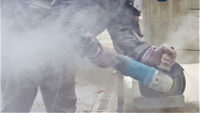A 2018 J.D. Power China Initial Quality Study found that the second-most prevalent problem among new car buyers was excessive fuel consumption. By a two-to-one margin the top complaint was “unpleasant interior smell/odor.” China is the world’s largest market for new car sales. Auto manufacturing companies, therefore, have taken great efforts to eliminate odors from new cars sold in China. Among various control actions, Ford was awarded a US patent in 2020 for a process to bake-out the VOCs contained in auto interior seats, carpet, plastics, etc., that are responsible for new car odor.
US consumers generally favor new car odor. The differences in consumer sentiments about odor between one country and another, results from many influences. Perception of harm is one influence. For example, see article Investigation of volatile organic compounds exposure inside vehicle cabins in China, 2015. The article found that VOCs in new vehicles in China included benzene, formaldehyde, toluene, xylene, ethylbenzene, styrene, acetaldehyde, acetone, and acrolein. The International Agency for Research on Carcinogens classifies benzene and formaldehyde as human carcinogens. The other chemicals may cause various health problems including upper respiratory irritation. Information in the referenced article may reach consumers in many ways, including word-of-mouth.
Chemicals
Odors are chemicals. How people are taught to interpret chemical exposures is very important. Excluding the one-hit theory of carcinogenesis, people in the USA, particularly OSHA HazCom trained workers, are taught that “dose makes the poison.” Airborne chemical exposures as time-weighted averages compared against regulations e.g., OSHA PELs and recommendations e.g., ACGIH TLVs, help establish if physiological, as opposed to psychological, harm from smelling odors will occur.
To help set your mind at ease, in the Chinese study above, none of the identified VOCs exceeded a PEL or TLV. Assuming the purchaser of a new car is a healthy adult, physiological harm will not result. Sensitive passengers e.g., very old or very young, should not experience any long-lasting harm either. Further, VOCs in new cars diminish by about 20 percent each week – quicker if the VOCs are baked-out by the Ford patent or otherwise. Regardless, new car odor will become non-detectable by the human nose in somewhat short time.
Detecting odors
How humans and other animals detect odors is an intriguing topic. Each OHS pro should understand the basics of odor as described in Wikipedia.
If all members of the animal kingdom are included, then every chemical has an odor. In separate studies reported this past March, C. elegans worms and F. fusca ants were “taught” to distinguish VOCs emitted from cancerous tissue, such as lung cancer. Worms and ants were taught to detect VOCs from cancerous tissue and non-cancerous tissue within days. Accuracy exceeded 70%. This new research holds much promise for rapid and inexpensive medical diagnostics. Search Open Access article iScience Ants detect cancer cells through volatile organic compounds, March 2022, for more information.
Manufactures, such as Kanomax and Scentroid, sell electronic “olfactometers” and other devices to capture VOCs for lab analysis or perform real-time measurements, that may help identify odors. With a little ingenuity, however, OHS pros may conceive how this advancing worm/insect research may be applied to a new line of instruments to detect odors in the workplace or elsewhere.
Minuscule odors
Dogs, worms, ants, and other creatures may detect odors at extremely small amounts. Humans may detect some chemical odors at very small amounts, too. For example, trimethylamine has a human odor threshold at 0.00021 ppm. This value may also be written as 0.21 parts per billion (ppb) or 210 parts per trillion (ppt). How small are these values?
One ppb is equivalent to one second in 32 years. One ppt is equivalent to one second in 32,000 years. The human odor threshold for trimethylamine, therefore, is equivalent to about one-fifth of a second in 32 years or about three and one-half minutes in 32,000 years! What was the earth like 32,000 years ago? The Ice Age and Neanderthals were around at that time.
The brain connection
Chemical molecules initiate electric signals that travel along olfactory nerve axons in the nose to the olfactory bulb in the limbic system of the brain, where odors are interpreted. Trimethylamine’s odor threshold may be interpreted by the brain as a fishy smell. At higher concentrations, the brain may interpret trimethylamine as fishy, pungent.
Whether people interpret the smell of trimethylamine as welcomed or offensive is a combination of evolution and experience. Research found that ethic people in China and ethnic people in New York interpreted the same odors differently. See “Body odor may smell worse to you than your ancient ancestors,” New York Times, February 2022. This research may help explain why people in China may dislike the new car smell while people in the US generally welcome the odor. The point: People may interpret odors differently.
Odor management
Odor management should be part of your OHS program. The first step in odor management is to inventory all odors at the workplace. Second step, identify the ppm level and source associated with the odor and compare with common exposure limits such as PEL and TLV. DNELs are sometimes helpful, too. Third step, communicate the inventory to workers during OSHA HazCom training, as odors are chemicals. Use wiki information to help explain odors to workers.
Unresolved odor complaints may elevate into conflict. Conflict often involves third parties such as OSHA to help resolve. Eliminate rather than mask offensive odors with a pleasant odor. Offensive odors may be captured if the chemical family is identified. For example, ethanolamine, triethanolamine, and 2-dibutyaminoethanol, all with low odor thresholds that produce a fishy smell, were emitted from a metalworking fluid process. See NIOSH Health Hazard Evaluation Report 2015-0070-3304, page 5. Air filters that contained activated alumina and potassium permanganate were attached onto exhaust outlets at mist collectors to reduce and eliminate odors from these amine chemicals.
Don’t let strange smells languish
If you read the NIOSH report above, I am the “second consultant that collected area air samples at the mist collector discharge for amines.” I am familiar with the worker health concerns that brought NIOSH into the workplace. It is my opinion that if management had an effective odor management program, as briefly described above, there would not have been a need for NIOSH’s involvement.




